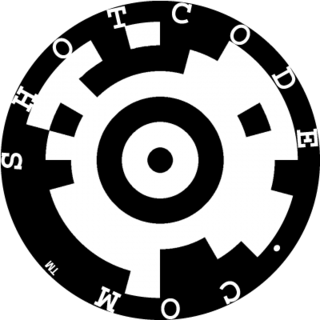
A barcode or bar code is a method of representing data in a visual, machine-readable form. Initially, barcodes represented data by varying the widths, spacings and sizes of parallel lines. These barcodes, now commonly referred to as linear or one-dimensional (1D), can be scanned by special optical scanners, called barcode readers, of which there are several types.
Tag Image File Format or Tagged Image File Format, commonly known by the abbreviations TIFF or TIF, is an image file format for storing raster graphics images, popular among graphic artists, the publishing industry, and photographers. TIFF is widely supported by scanning, faxing, word processing, optical character recognition, image manipulation, desktop publishing, and page-layout applications. The format was created by the Aldus Corporation for use in desktop publishing. It published the latest version 6.0 in 1992, subsequently updated with an Adobe Systems copyright after the latter acquired Aldus in 1994. Several Aldus or Adobe technical notes have been published with minor extensions to the format, and several specifications have been based on TIFF 6.0, including TIFF/EP, TIFF/IT, TIFF-F and TIFF-FX.
A barcode reader or barcode scanner is an optical scanner that can read printed barcodes and send the data they contain to computer. Like a flatbed scanner, it consists of a light source, a lens, and a light sensor for translating optical impulses into electrical signals. Additionally, nearly all barcode readers contain decoder circuitry that can analyse the barcode's image data provided by the sensor and send the barcode's content to the scanner's output port.

PDF417 is a stacked linear barcode format used in a variety of applications such as transport, identification cards, and inventory management. "PDF" stands for Portable Data File. The "417" signifies that each pattern in the code consists of 4 bars and spaces in a pattern that is 17 units (modules) long. The PDF417 symbology was invented by Dr. Ynjiun P. Wang at Symbol Technologies in 1991. It is defined in ISO 15438.

Semacode is a software company based in Waterloo, Ontario, Canada. It is also this company's trade name for their machine-readable ISO/IEC 16022 Data Matrix barcodes, which are used to encode Internet URLs.

A QR code is a type of two-dimensional matrix barcode, invented in 1994, by Japanese company Denso Wave for labelling automobile parts. It features black squares on a white background with fiducial markers, readable by imaging devices like cameras, and processed using Reed–Solomon error correction until the image can be appropriately interpreted. The required data is then extracted from patterns that are present in both the horizontal and the vertical components of the QR image.

A Data Matrix is a two-dimensional code consisting of black and white "cells" or dots arranged in either a square or rectangular pattern, also known as a matrix. The information to be encoded can be text or numeric data. Usual data size is from a few bytes up to 1556 bytes. The length of the encoded data depends on the number of cells in the matrix. Error correction codes are often used to increase reliability: even if one or more cells are damaged so it is unreadable, the message can still be read. A Data Matrix symbol can store up to 2,335 alphanumeric characters.
Object hyperlinking is a term that refers to extending the Internet to objects and locations in the real world. Object hyperlinking aims to extend the Internet to the physical world by attaching tags with URLs to tangible objects or locations. These object tags can then be read by a wireless mobile device and information about objects and locations retrieved and displayed.

A tracking system, also known as a locating system, is used for the observing of persons or objects on the move and supplying a timely ordered sequence of location data for further processing.

ShotCode is a circular barcode created by High Energy Magic of Cambridge University. It uses a dartboard-like circle, with a bullseye in the centre and datacircles surrounding it. The technology reads databits from the datacircles by measuring the angle and distance from the bullseye for each point.

Windows Live Barcode was a part of Microsoft's Windows Live services. It allowed users to transfer information between various media and handsets via Quick Response Code, a two-dimensional matrix barcode. It provided a method for people to exchange information and use various online services on handsets.
A guard tour patrol system is a system for logging the rounds of employees in a variety of situations such as security guards patrolling property, technicians monitoring climate-controlled environments, and correctional officers checking prisoner living areas. It helps ensure that the employee makes their appointed rounds at the correct intervals and can offer a record for legal or insurance reasons. Such systems have existed for many years using mechanical watchclock-based systems. Computerized systems were first introduced in Europe in the early 1980s, and in North America in 1986. Modern systems are based on handheld data loggers and RFID sensors. The system provides a means to record the time when the employee reaches certain points on their tour. Checkpoints or watchstations are commonly placed at the extreme ends of the tour route and at critical points such as vaults, specimen refrigerators, vital equipment, and access points. Some systems are set so that the interval between stations is timed so if the employee fails to reach each point within a set time, other staff are dispatched to ensure the employee's well-being. An example of a modern set-up might work as follows: the employee carries a portable electronic sensor (PES) or electronic data collector which is activated at each checkpoint. Checkpoints can consist of iButton semiconductors, magnetic strips, proximity microchips such as RFIDs or NFC- or optical barcodes. The data collector stores the serial number of the checkpoint with the date and time. Later, the information is downloaded from the collector into a computer where the checkpoint's serial number will have an assigned location. Data collectors can also be programmed to ignore duplicate checkpoint activations that occur sequentially or within a certain time period. Computer software used to compile the data from the collector can print out summaries that pinpoint missed checkpoints or patrols without the operator having to review all the data collected. Because devices can be subject to misuse, some have built-in microwave, g-force, and voltage detection.
Mobile tagging is the process of providing data read from tags for display on mobile devices, commonly encoded in a two-dimensional barcode, using the camera of a camera phone as the reader device. The contents of the tag code is usually a URL for information addressed and accessible through Internet.
CyberCode is a visual tagging system based on a 2D barcode technology. Designed to be read by low-cost CMOS or CCD cameras common in mobile devices, it can also be used to determine the 3D position of the tagged object as well as its ID number.
Asset tracking refers to the method of tracking physical assets, either by scanning barcode labels attached to the assets or by using tags using GPS, BLE, LoRa, or RFID which broadcast their location. These technologies can also be used for indoor tracking of persons wearing a tag.

The application Barcode Scanner is an Android app, from the open-source project ZXing, that allows an Android device with imaging hardware to scan barcodes or 2D barcodes and retrieve the data encoded. Information encoded often includes web addresses, geographical coordinates, and small pieces of text, in addition to commercial product codes. This Android-based system has similar functionality to a hardware barcode reader.
SnapTag, invented by SpyderLynk, is a 2D mobile barcode alternative similar to a QR code, but that uses an icon or company logo and code ring rather than a square pattern of black dots.

Screen-Smart Device Interaction (SSI) is fairly new technology developed as a sub-branch of Digital Signage.

Bing Vision is an image recognition application created by Microsoft which is installed on Windows Phones running version 7.5 and above, including Windows Phone 8. It is a part of the Bing Mobile suite of services, and on most devices can be accessed using the search button. On Windows Phone 8.1 devices where Microsoft Cortana is available, it is only available through the lenses of the Camera app. Bing Vision can scan barcodes, QR codes, Microsoft Tags, books, CDs, and DVDs. Books, CDs, and DVDs are offered through Bing Shopping.
Barcode library or Barcode SDK is a software library that can be used to add barcode features to desktop, web, mobile or embedded applications. Barcode library presents sets of subroutines or objects which allow to create barcode images and put them on surfaces or recognize machine-encoded text / data from scanned or captured by camera images with embedded barcodes. The library can support two modes: generation and recognition mode, some libraries support barcode reading and writing in the same way, but some libraries support only one mode.













